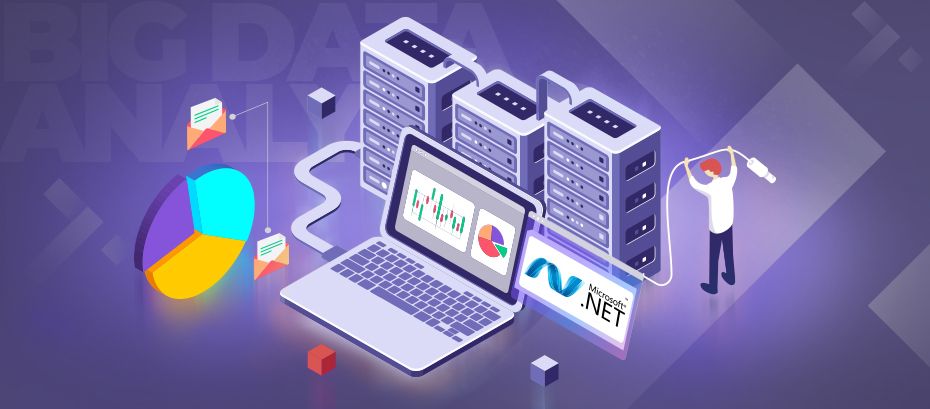
The volume of data is exploding beyond our imagination – from our behaviours, to our interactions, to our seemingly endless business/professional activities, everything is getting tracked, captured and stored.
According to a research carried out by DOMO, more than 2.5 quintillion bytes of data are created every single day. In addition to this, it is estimated that, by 2020, every person will generate 1.7 MB of data in just a second.
That’s huge! Isn’t it?
Whether you’re an IT services provider, a .NET development expert or planning to invest in .NET application development, it is important that you consider the ‘data explosion’ factor as it will soon matter to your customers if it doesn’t already.
This article talks about why it is beneficial to integrate Big Data Analytics with .NET applications.
Today, millions of developers across organizations of all sizes & segments count on Microsoft .NET Development Services to develop mission-critical applications.
This is mainly because of the following reasons:
- Free, open-source developer platform
- Cross-platform support
- Extensive class libraries
- Multi-language support
- Powerful tooling (provided by the Visual Studio family)
- Active community
- Requirement of less compute power
Planning to build a robust, scalable and secure .NET application?
We can help!
While .NET remains one of the most sought-after object-oriented programming language for developing enterprise applications, many organizations have started to realize the value of Big Data solutions – digitizing their data (from all aspects of their operations), moving it out of silos into data lakes, and building analytics solutions that derive actionable insights.
This brings us to a question…
Is .NET suitable for crunching Big Data?
The high-volume nature of Big Data often means that there is a requirement to crunch data files using long-running batch jobs to filter, aggregate, and otherwise prepare the data for analysis.
If you perform a search regarding the top languages for crunching Big Data, you will find that most of the sources will talk about Java, Python, R, and Scala.
Unfortunately, there are hardly any sources that will talk about .NET.
So, is .NET suitable to facilitate Big Data?
There is no reason why .NET can’t be used to facilitate Big Data. This is because anything that is written in Python or Java can be written in .NET too.
Also, the fact that Power BI, Microsoft’s well-known data analytics solution, can be connected to Hadoop makes Big Data crunching more appealing.
Another reason to choose .NET is that one can get the best out of highly flexible & scalable solutions that involve huge amount of data with the combination of IIS Web Server and .NET.
With that said, let’s dive into the advantages of integrating Big Data analytics with .NET solutions.
Benefits of integrating Big Data analytics with .NET:
1. Better Decision Making
2. Quick Issue Resolution
3. Data Accuracy
4. Cost Reduction
Looking to unleash the potential of Big Data analytics through Hadoop, Spark, or Storm?
We provide expertise in Big Data consulting and development services.
1) Better Decision Making
When organizations plan to integrate Big Data analytics with .NET, they get a platform to analyse massive amounts of data (in real time), identify patterns, and make data-driven decisions.
Furthermore, as the platform developed is customer-focused, it showcases its potential in a compelling manner.
2) Faster, More Effective Issue Resolution
With the infusion of Big Data analytics, organizations can use the solution to find answers to a number of business queries in a more detail-oriented fashion such as what their customers want, which segment to target, which new products to offer, who are their best customers, and why customers are turning to competitors.
Overall, the entire process of finding answers to complex questions becomes effective and quick.
3) Data Accuracy
By incorporating Big Data analytics into customer-specific question & answer process (for e.g. surveys, feedbacks and questionnaires), organizations can not only get a complete view of answers, but a more accurate view.
Moreover, the collected data can be combined with the history of customers (usually gathered through cookies) for planning purposes.
4) Cost Reduction
With Big Data analytics, there is a possibility to compress data at the most granular level, which not only reduces the storage requirements, but drives down the number of nodes and simplifies the infrastructure.
On the whole, there is a significant reduction in the data storage cost.
Bottom-line
Building .NET applications that possess the capabilities to learn from data and extract insights is what the .NET development community is focusing today. In fact, these are the applications which are highly demanded in the corporate world.
Moreover, with the integration of Big Data Analytics and .NET, organizations get an effective medium to craft customer personas that can help them drive digital strategy and shape highly-targeted campaigns.
Thinking about integrating Big Data Analytics with your .NET application?
We can help you combine the powers of both!



